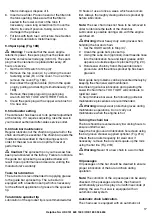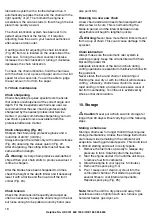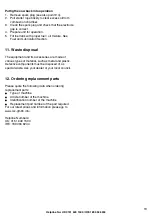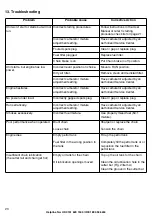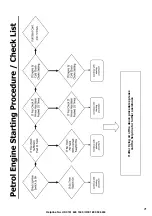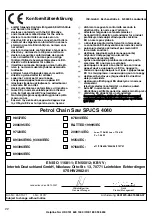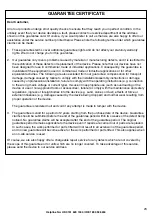
13
Helpline No: UK 0151 649 1500 / IRE 189 094 6244
around the end of the bar (Fig. 4B).
NOTE:
The saw chain may droop slightly on the lower
part of bar. This is normal.
4.
Pull the chain bar forward until the chain is closely
seated. Make sure that all the drive links are in
the groove of the bar.
5.
Fit the clutch cover and fasten it with 2 screws.
Make sure that the pivot (Fig. 3C/Item E) fits into
the chain bar (Fig. 3D/Item G). The chain must
not slip off the bar when you do this. Tighten the
two nuts by hand and then follow the instructions
for adjusting the tension in ADJUSTING THE
CHAIN TENSION.
5.3 Saw chain tension adjustment
Proper tension of saw chain is extremely important
and must be checked before starting, as well as
during any cutting operation.
Taking the time to make needed adjustments to the
saw chain will result in improved cutting performance
and prolonged chain life.
Warning:
Always wear heavy duty gloves when
handling saw chain or making saw chain adjustments.
1.
Before adjusting the chain tension screw you
must slacken the 2x retaining nuts. Otherwise this
will damage tension screw.
2.
Hold nose of guide bar up and turn adjustment
screw (D) CLOCKWISE to increase chain
tension. Turning screw COUNTERCLOCKWISE
will decrease amount of tension on chain. Ensure
the chain fits snugly all the way around the guide
bar (Fig. 5).
3.
After making adjustment, and while still holding
nose of bar in the uppermost position, tighten the
bar retaining nuts securely. Chain has proper
tension when it has a snug fit all around and can
be pulled around by gloved hand.
NOTE:
If chain is difficult to rotate on guide bar or if it
binds, too much tension has been applied. This
requires minor adjustment as follows:
A.
Loosen the bar retaining nut so they are finger
tight. Decrease tension by turning the bar
adjustment screw COUNTERCLOCKWISE
slowly. Move chain back and forth on bar.
Continue to adjust until chain rotates freely, but
fits snugly. Increase tension by turning bar
adjustment screw CLOCKWISE.
B.
When saw chain has proper tension, hold nose of
bar in the uppermost position and tighten the bar
retaining nut securely.
Caution:
A new saw chain stretches, requiring
adjustment after as few as 5 cuts. This is normal with
a new chain, and the interval between future
adjustments will lengthen quickly.
Caution:
If the saw chain is TOO LOOSE or TOO
TAUT, the drive wheel, chain bar, chain and crank
shaft bearing will suffer premature wear. Fig. 6 shows
the correct tension A (when cold) and tension B
(when warm). Fig. C shows a chain that is too loose.
6. Before starting the machine
6.1 Chain break mechanical test
Your chain saw is equipped with a Chain brake that
reduces possibility of injury due to kickback. The
brake is activated if pressure is applied against brake
lever when, as in the event of kickback, operator’s
hand strikes the lever. When the brake is actuated,
chain movement stops abruptly.
Warning:
The purpose of the chain brake is to
reduce the possibility of injury due to kickback;
however, it cannot provide the intended measure of
protection if the saw is operated carelessly. Always
test the chain brake before using your saw and
periodically while on the job.
To test chain brake
1.
The Chain brake is DISENGAGED (chain can
move) when BRAKE LEVER IS PULLED BACK
AND LOCKED (Fig. 7A).
2.
The chain brake is ENGAGED (the chain is
locked) when the brake lever is pulled forward
and the mechanism (Fig. 7B/Item A) can be
seen. It should not be possible to move the chain
(Fig. 7B).
NOTE:
The brake lever should snap into both
positions. If strong resistance is felt, or lever does not
move into either position, do not use your saw. Take it
immediately to a professional Service Center for
repair.
6.2 Fuel and lubrication
Fuel
Use regular grade unleaded fuel mixed with 50:1
custom 2-cycle engine oil for best results.
Mixing fuel
Mix fuel with 2 cycle oil in an approved container.
Shake gently and ensure thorough mix.

















